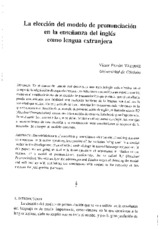La elección del modelo de pronunciación en la enseñanza del inglés como lengua extranjera
Autor
Pavón Vázquez, Víctor
Editor
UCOPressFecha
1999Materia
InglésAprendizaje
Segunda lengua
English
Second language
Learning
METS:
Mostrar el registro METSPREMIS:
Mostrar el registro PREMISMetadatos
Mostrar el registro completo del ítemResumen
En el marco del interés por desarrollar una metodología más efectiva en el campo de la adquisición de segundas lenguas, se debe prestar atención a un aspecto crucial, como es el establecimiento de un modelo de pronunciación que permita que el estudiante pueda comunicarse con facilidad con cualquier hablante de la lengua, sea cual sea la variedad que utilice. En este artículo se van a abordar las cuestiones más relevantes en lo que concierne a la elección de un modelo de pronunciación de inglés, el llamado acento RP (Received Pronunciation), en contra de la elección de otras variedades de gran importancia. Se analizarán las razones a las que se debe atender en el momento de elegir, las ventajas e inconvenientes de esta elección y se establecerán unas conclusiones al respecto de la necesidad de escoger un modelo concreto. The establishment of a mode] of pronunciation with the aim of making students communicate with native speakers, irrespective of the varieties being used, is a crucial matter in the development of an effective methodology in second language acquisition. In this paper. we are uoiril to deal with those questions of importance in relation to the election of a model of pronunciation, particularly, the so called RP (Received Promniciation). We will analyse the advantages and disadvantages of choosing the model and will end up with stablishing the conclusions with respect to the necessity of this election for peclagogical purposes.

